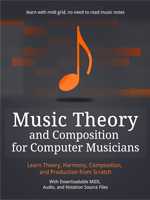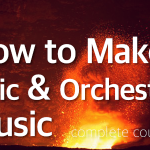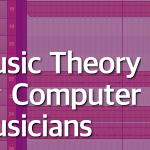Welcome to the first part of “How to Make Epic and Orchestral Music” course! This course, originally written as an ebook and now published as a series of articles, will teach you all the basic terms, concepts and practical skills you need to compose orchestral music using virtual instruments. While the track we’re about to create is far from the works of Thomas Bergersen, it’s a great introduction for beginners who want a way to start their composer journey.
Starting with Part 5, there will be 2 hours of videos on my YouTube channel, so you can follow me as I remake this entire track in real-time.
1. Before We Begin
Before I begin with introduction, here are some things I really want you to know about this guidebook. Hopefully, this part will get into the free chapter on Amazon, and you will read it without spending a single cent.
This is practical guidebook that teaches you, painfully and step by step, and probably in a little boring way, how to create a 1:15 minutes long basic epic music piece which I composed some time ago. The track is nice enough to share with listeners, yet simple enough to be great as an educational tool for beginners.
You will create something more or less similar – similarity will depend on the instruments you use: in other words, what kind of software you’re going to use, because there’s a lot of software you can use.
On the other hand, this is quite a theoretical guidebook – I explain a lot of basic things such as what are samplers and which orchestral library you should buy if you want to make cinematic music, but don’t want to spend countless amounts of money at the same time.
This book is meant for beginners. You don’t need to read music, you don’t have to know anything about the software we’ll be using. I will explain everything piece by piece. But you need to know basic music theory. Sure, you can go through this book, use my step-by-step suggestions and end up with your own music, but you really need to learn music theory later if you want to compose your own original pieces. Fortunately, I have written a second guidebook that explains music theory using MIDI editors and computer software.
I explain all the terms and concepts you need to know when new concept or term is introduced in this book. So you will learn some of the weird words.
I don’t provide you with everything you need to know to compose various types of orchestral music, but I give you everything to create the specific track composed for this guidebook.
At the same time, this knowledge is everything you need to know to make more original tracks and continue your education.
Learning music composition and orchestration is a complex topic, that would require thousands of pages to explain, and some of you will be glad about this (Adler’s orchestration guidebook [aff] is a 1000 pages long. And that’s just orchestration). Others not so much. I know a lot of people want to jump right into music production.
I’m happy to help you with that, by providing you with this guidebook. I know very well that those of you who won’t find this subject interesting won’t pursue it further, and those who find it exciting will start learning about all these things such as music theory, harmony, orchestration and so on.
Anyway, this guidebook is a practical one. I show you how to make an epic piece and I’m worried that by the time you’re done with this book, you will hate me for all these little details. But there is a benefit in learning through practice, so I hope you will stay with me and create the track from start to finish. Actually, some people prefer this kind of teaching – if you’re not one of those people, I still hope you will learn a thing or two.
For this track, I will use basic tools and basic knowledge. I will explain some things and skip the other. For example, I will explain what chords are, but I won’t bore you with worrying about consecutive fifths; I will tell explain why I decided to use A Minor scale, but I won’t bore you with various modes and corresponding moods in music composition. As I said, music composition is a complex subject, and I just want to get you the basics so you can actually start making cinematic and epic music by yourself.
I will also use simple tools, such as Reaper, a simple DAW software, and many instruments that come with full version of Kontakt 5. But I will also use some more advanced instrument libraries such as CineBrass CORE, because seriously, you can’t achieve epicness without some awesome legato French Horns!
And if you don’t understand any of the terms above, don’t worry. We’ll get to that very soon in the next couple parts of this series.
What You Will Need
You’re going to need a couple of things. Here’s a list, and on the following pages I will explain them in more detail.
- A computer – powerful enough to make music. I suggest at least an i5 CPU with 3.0 Ghz, 8 GB of RAM and a hard drive with 7200 RPM. 16 GB or RAM and an SSD is preferred.
- A DAW – this word stands for Digital Audio Workstation, it’s the main piece of software inside which you will make the music.
- A sampler – a “program within program” that runs all the instruments.
- Instrument libraries – well, these are the instruments that work in the sampler and replace notes we’re typing into actual sounds.
I have used Reaper and Kontakt 5, the first one is the DAW and the second one is the sampler. I have used the following libraries for making my piece:
- Kontakt Factory
- Epic Toms by 8Dio
- CineBrass Core by CineSamples
- Strezov’s Storm Choir
Now, you can use other orchestral libraries (and I will offer you some examples soon enough, so don’t go shopping just yet), but if you do, you may need to change some settings, switch octaves, change the “notes” of the drum patches etc, because some settings, notes and levels vary between different libraries. For example, if you don’t have CineBrass CORE, but you use French Horns from Kontakt Factory, you will have to switch mod wheel control for expression control, you will lack legato and you will have to change the velocity and expression to get a better sound from such basic library. This is normal. There are many instrument libraries available these days, they all sound a bit different, have different settings and different programming. This is part of the reason why teaching this kind of music production is difficult – your readers don’t always have the same libraries.
Just prepare yourself – if you use different libraries, you need patience and you may also need to read the instrument’s manuals to achieve similar results.
There is no better way to learn things than through practice. When you learn programming, you grab a guidebook and go page after page, typing things on your own computer. And when you learn music, you need to make music – either on a real instrument, or on the computer.
Before You Start
Making orchestral music is hard. If you really want to do this, then be prepared to spend a lot of time, money and effort on this. Hardware and software costs money, but also don’t forget about education. This book is an introduction which covers the basics. But composition and orchestration are both very complex topics that takes years to learn. Your first works won’t be perfect, but only through learning and practicing you can improve your skills.
That said, if you’re only interested in a hobby, I guess you won’t have to spend more than 1500-2000 dollars, and even this not at the same time. You can start by spending about 550 dollars on a all-in-one music library, such as Albion, Symphobia or one of the Metropolis Arks, that works in a free version of Kontakt 5 player with no limitations, and another 60 dollars for a Reaper DAW (which, by the way, has 60 days of free trial).
What About Music Theory?
Let’s say you don’t know music theory, that means you don’t know what notes are, what chords are, what chord progression is and so on. In this case, you should learn this before trying to make music on your computer. It will save you a lot of stress and time. How to learn music theory? YouTube is a great source of knowledge. There’s also a lot of books for beginners.
I recommend two main ways to learn music theory. You can read two books I really recommend, “Music Theory for Dummies” and “Music Composition for Dummies”. This will give you the basic understanding of the building blocks of music.
And of course, there’s a complete course on this website: music theory for computer musicians! (at the moment of writing these words, it’s already finished, but the articles are being published as a series and they should all be available by September of 2019).
Photo source: Pixabay CC0
Don't forget to become a fan on Facebook and subscribe to new posts via RSS or via email.







